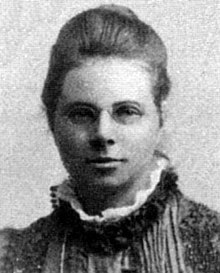Hilda Phoebe Hudson
Hilda Phoebe Hudson | |
|---|---|
 Hilda Phoebe Hudson | |
| Born | 11 June 1881 Cambridge, England |
| Died | 26 November 1965 Chiswick, London, England |
| Nationality | British |
| Education | Cambridge and Berlin |
| Occupation | mathematician |
| Known for | Cremona transformation |
| Parent(s) | Professor William Henry Hoare Hudson |
Hilda Phoebe Hudson (11 June 1881 Cambridge – 26 November 1965 London) was an English mathematician who worked on algebraic geometry, in particular on Cremona transformations. Hudson was interested in the link between mathematics and her religious beliefs.
Life and work[]
In 1900 Hudson gained a scholarship and entered Newnham College at the University of Cambridge, graduating in 1903, coming 7th equal among the First Class students. After a year of further study at the University of Berlin, she returned to Newnham in 1905, first as lecturer in mathematics and later as Associate Research Fellow. Trinity College Dublin awarded her an ad eundam MA, and later a DSc, in 1906 and 1913, respectively.[1]
She was an Invited Speaker of the International Congress of Mathematicians (ICM) in 1912 at Cambridge UK.[2] Although Laura Pisati had been invited to the 1908 ICM, she died just before the start of the conference, so Hudson became the first female invited speaker at an ICM.[3]
She spent the academic year 1912–1913 at Bryn Mawr in the US, and the years 1913–1917 back in England, this time as lecturer at West Ham Technical Institute. She joined an Air Ministry subdivision undertaking aeronautical engineering research in 1917, where she applied pioneering work on the application of mathematical modelling to aircraft design.[4] She was appointed OBE in 1919. As a distinguished mathematician she was one of the few women of her time to serve on the council of the London Mathematical Society.
Most of Hudson's pure mathematical research was concerned with surfaces and plane curves, her special interest being in Cremona transformations. Her 1916 monograph Ruler and Compasses[5] was well-received as "a welcome addition to the literature on the boundary between elementary and advanced mathematics".[6] Her 454-page 1927 treatise Cremona transformations in plane and space is considered by John Semple to be her magnum opus.[7]
Epidemiology[]
Hudson published work with Ronald Ross on epidemiology and the measurement of disease spread.[8] [9] "The classical susceptible-infectious-recovered (SIR) model, originated from the seminal papers of Ross and Ross and Hudson in 1916-1917 and the fundamental contributions of Kermack and McKendrick in 1927-1932, describes the transmission of infectious diseases between susceptible and infective individuals and provides the basic framework for almost all later epidemic models."[10]
Books[]
- Ruler and Compasses, first published as a monograph (Longman's Modern Mathematical Series, 1916) and then included in the compendium Squaring the circle and other monographs (Chelsea n.d.)
- Cremona Transformations in Plane and Space, Cambridge University Press, 1927.
References[]
- ^ Hudson, Hilda Phoebe in Oxford Dictionary of National Biography
- ^ Hudson, H. P. "On binodes and nodal curves". In: Proceedings of the Fifth International Congress of Mathematicians (Cambridge, 22–28 August 1912). vol. 2. pp. 118–121.
|volume=has extra text (help) - ^ Mihaljević, Helena; Roy, Marie-Françoise (2019). "A Data Analysis of Women's Trails Among ICM Speakers". In Araujo, Carolina; Benkart, Georgia; Praeger, Cheryl E.; Tanbay, Betül (eds.). World Women in Mathematics 2018. Association for Women in Mathematics Series. Springer International Publishing. pp. 111–128. arXiv:1903.02543. doi:10.1007/978-3-030-21170-7_5. S2CID 70349983.
- ^ Royle, Tony (1 November 2017). "The impact of the women of the Technical Section of the Admiralty Air Department on the structural integrity of aircraft during World War One" (PDF). Historia Mathematica. 44 (4): 342–366. doi:10.1016/j.hm.2017.06.001. ISSN 0315-0860.
- ^ Hudson, Hilda P. (1916). Ruler and Compasses. London: Longmans, Green and Company.
- ^ Review of Ruler and Compasses, 1916
- ^ In: University of St Andrews, Biographies: This [Cremona transformations in plane and space] was indeed her magnum opus, the culminating achievement of many years of scholarly research, in which she gathered into one connected account all the essential elements of what had long been a fashionable field of research and supplemented it with an impressive bibliography (37 pages and 417 items) covering sixty to seventy years of publications on the subject.
- ^ Ross, Ronald; Hudson, Hilda (3 May 1917). "An application of the theory of probabilities to the study of a priori pathometry.—Part II". Proceedings of the Royal Society A: Mathematical, Physical and Engineering Sciences. 93 (650): 212–225. Bibcode:1917RSPSA..93..212R. doi:10.1098/rspa.1917.0014.
- ^ Ross, Ronald; Hudson, Hilda (1917). "An application of the theory of probabilities to the study of a priori pathometry.—Part III". Proceedings of the Royal Society B: Biological Sciences. 89 (621): 507. Bibcode:1917RSPSA..93..225R. doi:10.1098/rspa.1917.0015.
- ^ Magal, Pierre; Ruan, Shigui (April 2014). "Susceptible-infectious-recovered models revisited: from the individual level to the population level". Math Biosci. 250: 26–40. doi:10.1016/j.mbs.2014.02.001. PMID 24530806.
External links[]
- O'Connor, John J.; Robertson, Edmund F., "Hilda Phoebe Hudson", MacTutor History of Mathematics archive, University of St Andrews
- Semple, J. G. (1969), "Hilda Phoebe Hudson", The Bulletin of the London Mathematical Society, 1 (3): 357–359, doi:10.1112/blms/1.3.357, ISSN 0024-6093, MR 0246741
- A list of her papers can be found at Biographies of Women Mathematicians: Hilda Phoebe Hudson
- 1881 births
- 1965 deaths
- English mathematicians
- People from Cambridge
- Women mathematicians
- English women non-fiction writers
- English non-fiction writers
- 20th-century English women writers
- 20th-century English writers
- British women engineers
- 20th-century women engineers
- Steamboat ladies